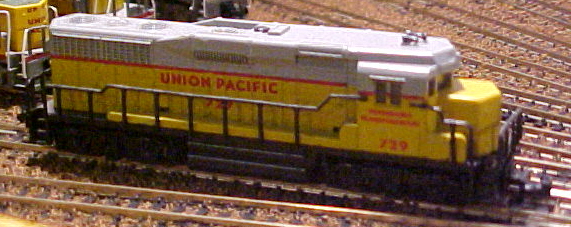



Introduced: 1974 (discontinued circa 1982)
These two models came out at pretty much the same time and have the exact same chassis/mechanism. So, to save myself a bit of time I'm going to cover them both here.
Though not particularly impressive by modern standards, these models do have a few novel innovations for their day. First off, the walkway/handrail assembly is a separate part from the rest of the shell. Also, the handrails are composed of a more flexible plastic than normally found in 1970s-era handrails ("pathetically brittle" generally being the rule of the day). Also, the handrails have a bit of 3-D detailing to them (as opposed to the flat and featureless handrails offered up by the likes of Mehano, et al).

The mechanism is similar in design to the one introduced in Roco's 1973 F9 model, with the main difference being the free-floating weight plunked onto the top of the chassis. The motor is an open-sided 3-poler. It turns dual driveshafts which are connected to several plastic connectors, which are in turn connected to the worm gears (hidden away inside their little towers). All of the gearing is plastic (that weirdo red stuff that Roco was so fond of). All wheels are geared and provide pickup (no traction tires). Current is transferred to the motor via a veritable rat's nest of wiring (and good luck re-soldering those truck wires if they come de-soldered on you). A non-directional headlight is mounted on top of the free-floating chassis weight. Rapido-style couplers are mounted to the trucks.
Performance is about the same as on Roco's F9, and pretty typical of 1970s-era Roco design. First and foremost, these things are extremely noisy (kind of odd, given the fact that all of the gearing is plastic). I don't know if the fault lies in the design or the manufacture, but something just ain't meshing together quite right in there. Pickup can be decent (if yours has aged well), but more often than not performance tends to be a bit jittery these days (either due to contacts coming desoldered, wheel wipers not wiping properly, or some other nameless malady). I'm not real impressed with the motor either. My Geeps require a huge amount of throttle before they start moving (and when they do decide to get going, they go). Not surprisingly, the top-end speed is pretty much off the charts. Pulling power is decent. The wheels flanges are somewhat oversized, so it's unlikely these could be operated on Code-55 track.
So, all things considered, not terrible locomotives. But definitely too many deficiencies for them to find a place in a modern operational fleet.
AFAIK, these models received no modifications or upgrades during their production run. They were ultimately discontinued in the early 1980s when Atlas dropped their entire line of Roco-made locomotives (a direct result of Atlas's new partnership with Kato).
Be careful when bidding on an Atlas GP30 or GP9 on eBay. You might think you're bidding on one of the newer (and vastly superior) Kato or Chinese-made versions, but instead you might actually be bidding on one of these things. If there's any doubt, ask about the bottom of the fuel tank. These Roco-made units are stamped "Atlas - Made in Austria".
Trivia - I'm told that the GP9 body shell is based on a "Phase 3a" prototype (and the only N scale model ever made of that particular Geep sub-genre).
To remove the shell, free the handrails from the cab and then slide it up and off. To remove the walkway/handrail piece, slide out the metal bar running through the forward truck tower (yeah, what a pain). The walkway piece should slide up and off at that point.
Grade: C
GP9 Reviewed: 2/75 Model Railroader: ("The ready-to-run Atlas model, manufactured in Austria, follows the proportions of the prototype. The height is about 9" in excess of the prototype dimension. The body is a one-piece plastic casting with all details cast on, except for the air horns. The railings, steps and walkways are another one-piece plastic casting. The frame is composed of zinc-alloy castings. A three-pole DC motor drives all 8 wheels through a worm and gear and spur gear mechanism. All gears are hard plastic. The trucks and truck gearboxes are also cast plastic. Rapido-type automatic couplers are truck-mounted. The scale 43"-diameter wheels are metal. All wheels provide electrical pickup through a wiper system. The flanges are .032" deep and check gauge is .312". Our sample ran smoothly through all speed ranges after a light application of lubricant to the gear train... The model has a high starting speed... The model is well detailed and has good performance characteristics. AT&SF, Rio Grande, BN, N&W, C&NW. Price: $20")
GP30 Reviewed: 5/75 Model Railroader ("The model is an excellent representation of its prototype. It closely follows dimensions on (prototype) drawings. The body is a one-piece plastic casting with most details molded on. The frame is a zinc-alloy casting. The steps, side platforms, and end platforms are a one-piece plastic casting. A weight which fits over the motor and drive train is a zinc alloy casting. The gearboxes and sideframes are plastic; the wheels are metal. Plastic worm-and-gear and spur gears are used in the drive train to power all axles on both trucks. The motor is a small 3-pole, double-ended type. All wheels are used for electrical pickup, providing good contact. The model has truck-mounted Rapido-type couplers at each end. Our sample ran smoothly. More sophisticated transistor controls or pulse power will decrease the minimum speed, which is otherwise high. The model should be able to pull 26 to 28 average N scale freight cars with ease. SF, UP, Burlington, PRR, C&O. $20")